
Cet article présente principalement le processus d'initiation et de révision php+ajax (en prenant congé comme exemple). Les amis dans le besoin peuvent s'y référer
Laissez-moi d'abord parler de l'idée :
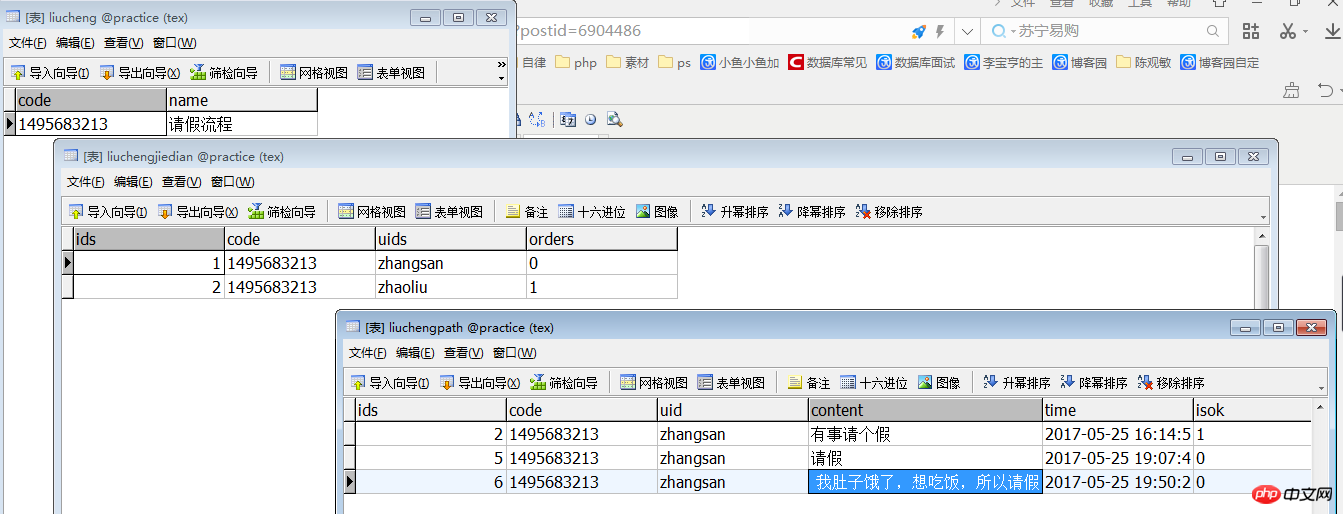
<!DOCTYPE html> <html> <head> <meta charset="UTF-8"> <title></title> </head> <body> <form method="post" action="denglu-cl.php"> 用户名:<input type="text" name="uid" /><br /> 密码:<input type="password" name="pwd" /><br /> <input type="submit" value="登录" /> </form> </body> </html>
<?php
session_start();
require "../DB.class.php";
$db = new DB();
$uid = $_POST["uid"];
$pwd = $_POST["pwd"];
$sql = "select pwd from users where uid='{$uid}'";
$mm = $db->strquery($sql);
if($pwd==$mm && !empty($pwd))
{
$_SESSION["uid"]=$uid;
header("location:liucheng.php");
}
else
{
echo "密码或登录名输入错误";
}
?>
<!DOCTYPE html>
<html>
<head>
<meta charset="UTF-8">
<title></title>
<style>
#body{
height: 200px;
width: 300px;
background-color: gainsboro;
margin: 200px auto;
text-align: center;
vertical-align: middle;
line-height: 30px;
}
</style>
</head>
<body>
<p id="body">
<h2>主页面</h2>
<p>
<a href="faqi.php" rel="external nofollow" >发起流程</a><br />
<a href='shenhe.php'>审核流程</a>
</p>
</p>
</body>
</html>
<!DOCTYPE html>
<html>
<head>
<meta charset="UTF-8">
<title></title>
<style>
#body{
height: 250px;
width: 300px;
background-color: gainsboro;
margin: 200px auto;
text-align: left;
vertical-align: middle;
line-height: 30px;
padding-left: 30px;
}
</style>
</head>
<body>
<p id="body">
<form method="post" action="faqi-cl.php">
<h2>发起流程页面</h2>
<select id="lc">
<?php
require "../DB.class.php";
$db = new DB();
$sql = "select * from liucheng";
$arr = $db->query($sql);
foreach($arr as $v)
{
echo "<option value='{$v[0]}'>{$v[1]}</option>";
}
?>
</select><br />
发起流程事由:
<textarea class="nr"> </textarea><br />
<input type="button" value="确定发起" />
</form>
</p>
</body>
</html>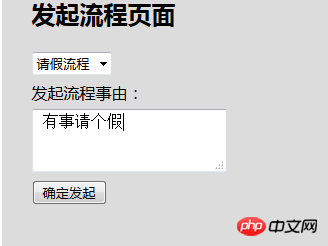
Étape 4 : Rédiger la page de traitement fq-cl.php pour le processus d'initiation
<?php
session_start();
require "../DB.class.php";
$db = new DB();
$code = $_POST["lc"];
$nr =$_POST["nr"];
$uid = $_SESSION["uid"];
$time = date("Y-m-d H:i:s",time());
$sql = "insert into liuchengpath values ('','{$code}','{$uid}','{$nr}',0,'{$time}',0)";
$db->query($sql,0);
header("location:liucheng.php");
?>Cliquez sur "Confirmer l'initiation" et cela sera ajouté à la base de données. Données

Étape 5 : Examen du processus page shenhe.php
Points de connaissance utilisés : Sous-requête : Sous-requête non pertinente (la sous-requête et la requête parent peuvent être exécutées indépendamment Sous-requête associée (la condition dans la sous-requête utilise quelque chose de la requête parent)
;
<!DOCTYPE html>
<html>
<head>
<meta charset="UTF-8">
<title></title>
<style>
#body{
height: 450px;
width: 800px;
background-color: gainsboro;
margin: 200px auto;
text-align: left;
vertical-align: middle;
line-height: 30px;
padding-left: 30px;
}
</style>
</head>
<body>
<p id="body">
<h2>流程审核页面</h2>
<?php
session_start();
$uid = $_SESSION["uid"];
require "../DB.class.php";
$db = new DB();
//先取该用户参与的所有流程
//并且取流程步骤到达该用户或已经被改用户审核通过的记录
$sql="select * from liuchengpath a where code in(select code from liuchengjiedian where uids='{$uid}') and towhere >=(select orders from liuchengjiedian b where b.code = a.code and b.uids = '{$uid}')";
$arr = $db->query($sql);
//var_dump($arr);
echo "<table border='1' width='100%' cellpadding='0' cellspacing='0'>
<tr>
<td>流程代号</td>
<td>发起者</td>
<td>发起内容</td>
<td>发起时间</td>
<td>是否结束</td>
<td>操作</td>
</tr>";
foreach($arr as $v){
//操作最后一列
//设置默认项
$zt = "<a href='tongguo-cl.php?code={$v[0]}'>审核未通过</a>";
$sql = "select orders from liuchengjiedian where code ='{$v[1]}' and uids ='{$uid}'";
$wz = $db->strquery($sql);
if($v[6]>$wz)
{
$zt = "<span style='color:green'>审核已通过</span>";
}
echo "<tr>
<td>{$v[1]}</td>
<td>{$v[2]}</td>
<td>{$v[3]}</td>
<td>{$v[4]}</td>
<td>{$v[5]}</td>
<td>{$zt}</td>
</tr>";
}
echo "</table>";
?>
</p>
</body>
</html>Étape 6 : Écrire la page tongguo -cl.php (important)
<?php
$ids = $_GET["code"];
require "../DB.class.php";
$db = new DB();
//点击审核后,towhere列加1,目的是使流程向下走
$sql = "update liuchengpath set towhere = towhere+1 where ids ='{$ids}' ";
$db->query($sql,0);
//当流程走到最后一个审核的人时,流程要结束
//获取该流程最大的orders
$sql =" select max(orders) from liuchengjiedian where code = (select code from liuchengpath where ids ='{$ids}')";
$maxorders = $db->strquery($sql);
//获取该用户处于哪个位置,也就是towhere等于多少
$sql ="select towhere from liuchengpath where ids ='{$ids}'";
$towhere = $db->strquery($sql);
//判断是否已到达最后一个审核的人
if($towhere>$maxorders)
{
$sql = "update liuchengpath set isok=1 where ids='{$ids}'";
// var_dump($sql);
$db->query($sql,0);
}
header("location:shenhe.php");
?>Quand cette étape est écrite, cliquez sur "Audit non réussi" et elle deviendra "Audit réussi" »

Vérifions l'effet depuis le début :
Premièrement : lancer un nouveau processus de congé :
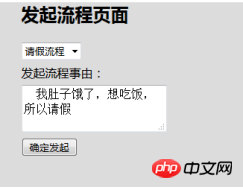

Deuxièmement : Zhangsan est la première personne à être examinée
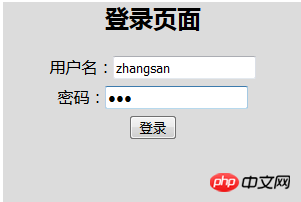

Cliquez sur "Après l'échec de la révision",

Enfin : zhaoliu est le dernier évaluateur
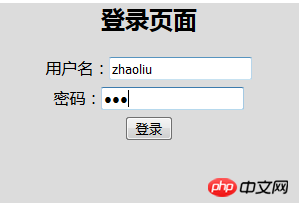

Cliquez sur "Pas encore révisé" Après réussite", si la fin passe à 1 ; l'opération passe au vert "Audit réussi" ~~~

Recommandations associées :
instruction continue dans le contrôle de flux php
instruction break dans le flux php contrôle
Qu'est-ce que le contrôle de flux php est foreach
Ce qui précède est le contenu détaillé de. pour plus d'informations, suivez d'autres articles connexes sur le site Web de PHP en chinois!
 Comment ouvrir le fichier php
Comment ouvrir le fichier php
 Comment supprimer les premiers éléments d'un tableau en php
Comment supprimer les premiers éléments d'un tableau en php
 Que faire si la désérialisation php échoue
Que faire si la désérialisation php échoue
 Comment connecter PHP à la base de données mssql
Comment connecter PHP à la base de données mssql
 Comment connecter PHP à la base de données mssql
Comment connecter PHP à la base de données mssql
 Comment télécharger du HTML
Comment télécharger du HTML
 Comment résoudre les caractères tronqués en PHP
Comment résoudre les caractères tronqués en PHP
 Comment ouvrir des fichiers php sur un téléphone mobile
Comment ouvrir des fichiers php sur un téléphone mobile